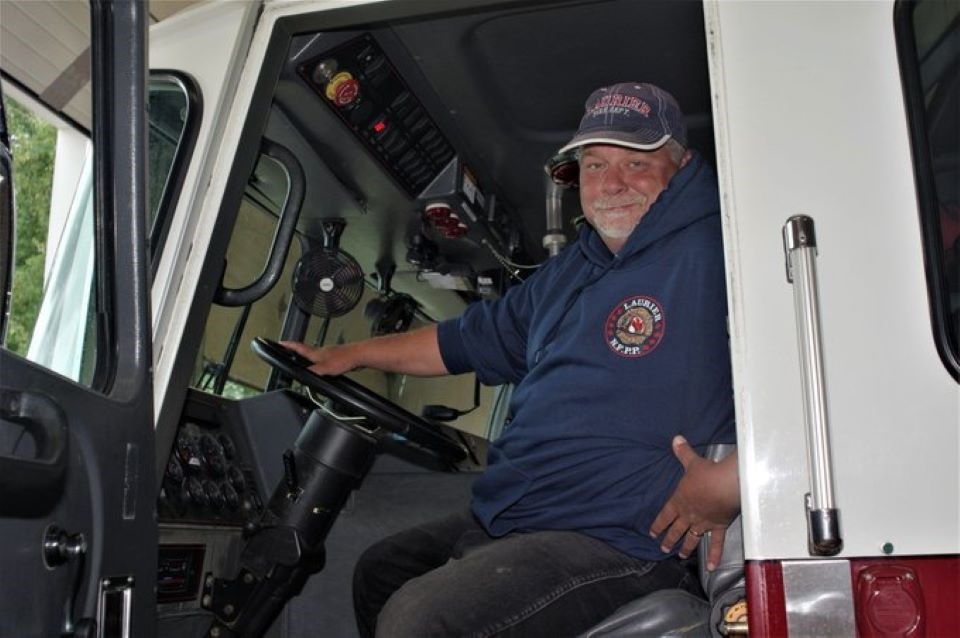Laurier Township Fire Chief Tim Hollands has been a man on a mission for the last few years.
Hollands wants more fire services, especially those in southern Ontario, to know more about the Northern Fire Protection Program (NFPP).
The Office of the Fire Marshal in Ontario oversees the NFPP, which provides fire protection to unorganized communities including Laurier Township, south of Trout Creek.
The NFPP division of the Fire Marshal’s Office has been around for decades but Hollands says before its creation, the Ministry of Natural Resources was responsible for responding to fires in unorganized territories in the north.
However, given the large distances between MNR firefighting stations and the remote northern communities they serve, Hollands says there were instances when firefighters couldn’t get to a scene in time.
Hollands says such was the case years ago in Hurkett, a community of only 236 people near Thunder Bay, where children died in a house fire.
Hollands says the fatal consequences made people realize there was a need to provide fire protection services in these small unorganized communities that didn’t have their own fire service.
And so the Northern Fire Protection Program was created under the umbrella of the Fire Marshal’s Office.
Hollands has some startling numbers to give people an idea of just how much territory the individual NFPP departments, which are made up of volunteers, cover.
He says in terms of geography, southern Ontario makes up only 12 per cent of the entire land mass in the province and northern Ontario makes up the remaining 88 per cent.
Hollands adds out of that 88 per cent in the north, organized municipalities only occupy 16 percent of the land mass while unorganized territories like Laurier, make up the remaining 84 per cent.
This 84 per cent land mass is home to about 200 unorganized municipalities with a total population of 40,000 people.
Hollands says among the 200 unorganized communities, only 47 have their own NFPP department of which Laurier is one.
Twenty of the NFPPs are in northeastern Ontario and 27 are in northwestern Ontario.
Hollands says other nearby NFPP stations are located in Restoule, Britt, Phelps and Argyle.
Laurier has a population of only 189 people, is the most southern of all the NFPPs in the north and has a land mass of 183 square kilometres.
Hollands says in terms of size his coverage area is small because some NFPPs in more remote unorganized townships have coverage areas “of upwards of 600 square kilometres.”
Despite the fact the NFPPs have been around for decades, Hollands says there are fire officials in southern Ontario who don't know they exist at all and those that do have a poor understanding of them.
“I was at a conference about four years ago and a gentleman at one of the booths representing a large group of firefighters didn’t know what the NFPP was when I mentioned it,” Hollands said.
“I just shook my head but at that point, it became a goal of mine to get the NFPP name out there. I wanted to have the stigma that the NFPPs seem to have taken away. I wanted to make the NFPP name more respectful and point out that it’s a fire service that’s equal with other fire services.”
Hollands says next to Toronto and Ottawa, the NFPP is the third largest fire service in all of Ontario with its 47 stations spread across the north.
Hollands says an NFPP firefighter will engage in the same training that firefighters in organized communities take part in and that includes all the paperwork.
He says the difference between an NFPP fire department and a fire service in an organized community is the NFPP is partially funded by the Ontario government because the small communities with an NFPP don’t have a large tax base to draw from.
“We’re given bunker gear, hoses, nozzles and training material,” Hollands said, adding he believes this may be where the negativity comes from other fire services because they don’t understand the tax dollar limitations these small communities face.
Hollands says these small unorganized communities still have a fire budget, even though it’s small and what the budget can’t buy, or the Ontario government can’t supply, Hollands says the departments “scrimp and save” as he does with his fire service.
Hollands says when he’s at an event and thoroughly explains to his southern Ontario colleagues how an NFPP fire service works, “the light bulb goes on.”
“They see the reason why we’re here and understand,” he said.
“They understand that the NFPP is there to help residents in a community.”
Nowadays when Hollands is online and engaged in activities involving the Ontario Association of Fire Chiefs, he adds as much NFPP content as possible in that conversation.
When he attends conferences he makes a point of talking about the NFPPs and the work they do.
“My trucks and gear all have NFPP on them,” he said.
“And we have ‘NFPP Proud’ T-shirts. I do this because I feel it needs to be done.”
Hollands does this with the full awareness of the NFPP Fire Chiefs in northern Ontario and says he gets positive responses from his fellow fire chiefs.
For Hollands the bottom line is he wants other fire services to understand the NFPP is no different from theirs.
“We’re not exempt from anything,” he said.
“We do the training, the testing, the paperwork and certification. We’re still firefighters who go out at 2:30 in the morning and risk our necks just like the other fire services.”
Rocco Frangione is a Local Journalism Initiative reporter who works out of the North Bay Nugget. The Local Journalism Initiative is funded by the Government of Canada



